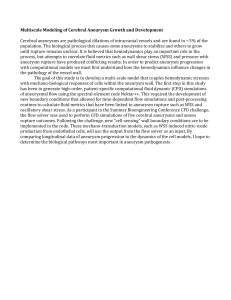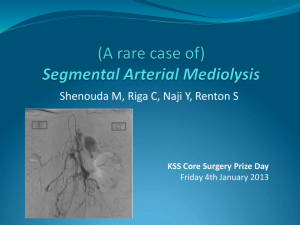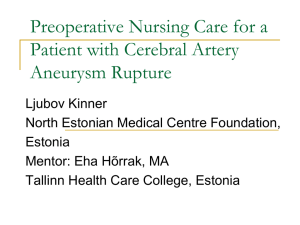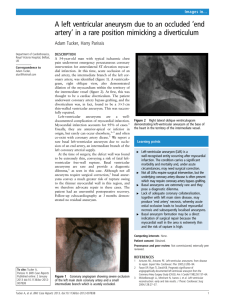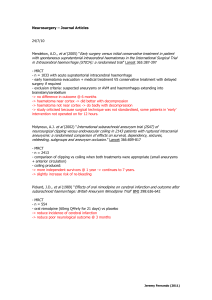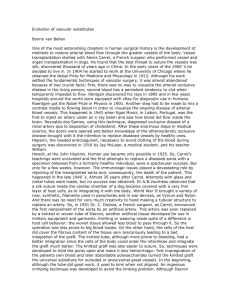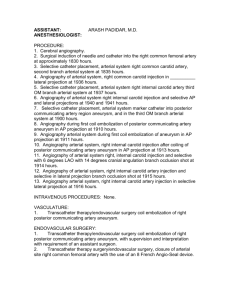Brachial Artery Aneurysm
advertisement
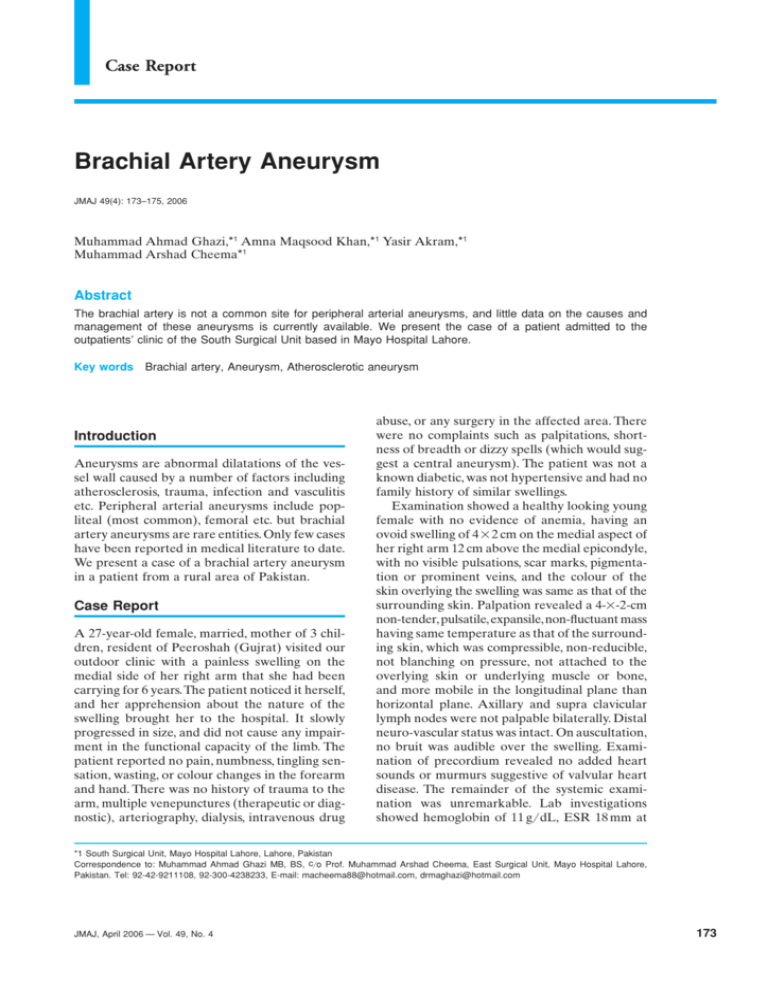
Case Report Brachial Artery Aneurysm JMAJ 49(4): 173–175, 2006 Muhammad Ahmad Ghazi,*1 Amna Maqsood Khan,*1 Yasir Akram,*1 Muhammad Arshad Cheema*1 Abstract The brachial artery is not a common site for peripheral arterial aneurysms, and little data on the causes and management of these aneurysms is currently available. We present the case of a patient admitted to the outpatients’ clinic of the South Surgical Unit based in Mayo Hospital Lahore. Key words Brachial artery, Aneurysm, Atherosclerotic aneurysm Introduction Aneurysms are abnormal dilatations of the vessel wall caused by a number of factors including atherosclerosis, trauma, infection and vasculitis etc. Peripheral arterial aneurysms include popliteal (most common), femoral etc. but brachial artery aneurysms are rare entities. Only few cases have been reported in medical literature to date. We present a case of a brachial artery aneurysm in a patient from a rural area of Pakistan. Case Report A 27-year-old female, married, mother of 3 children, resident of Peeroshah (Gujrat) visited our outdoor clinic with a painless swelling on the medial side of her right arm that she had been carrying for 6 years. The patient noticed it herself, and her apprehension about the nature of the swelling brought her to the hospital. It slowly progressed in size, and did not cause any impairment in the functional capacity of the limb. The patient reported no pain, numbness, tingling sensation, wasting, or colour changes in the forearm and hand. There was no history of trauma to the arm, multiple venepunctures (therapeutic or diagnostic), arteriography, dialysis, intravenous drug abuse, or any surgery in the affected area. There were no complaints such as palpitations, shortness of breadth or dizzy spells (which would suggest a central aneurysm). The patient was not a known diabetic, was not hypertensive and had no family history of similar swellings. Examination showed a healthy looking young female with no evidence of anemia, having an ovoid swelling of 4⳯2 cm on the medial aspect of her right arm 12 cm above the medial epicondyle, with no visible pulsations, scar marks, pigmentation or prominent veins, and the colour of the skin overlying the swelling was same as that of the surrounding skin. Palpation revealed a 4-⳯-2-cm non-tender, pulsatile, expansile, non-fluctuant mass having same temperature as that of the surrounding skin, which was compressible, non-reducible, not blanching on pressure, not attached to the overlying skin or underlying muscle or bone, and more mobile in the longitudinal plane than horizontal plane. Axillary and supra clavicular lymph nodes were not palpable bilaterally. Distal neuro-vascular status was intact. On auscultation, no bruit was audible over the swelling. Examination of precordium revealed no added heart sounds or murmurs suggestive of valvular heart disease. The remainder of the systemic examination was unremarkable. Lab investigations showed hemoglobin of 11 g/dL, ESR 18 mm at *1 South Surgical Unit, Mayo Hospital Lahore, Lahore, Pakistan Correspondence to: Muhammad Ahmad Ghazi MB, BS, c/o Prof. Muhammad Arshad Cheema, East Surgical Unit, Mayo Hospital Lahore, Pakistan. Tel: 92-42-9211108, 92-300-4238233, E-mail: macheema88@hotmail.com, drmaghazi@hotmail.com JMAJ, April 2006 — Vol. 49, No. 4 173 Ghazi MA, Khan AM, Akram Y, et al. 174 Fig. 1 Brachial artery aneurysm during dissection Fig. 2 After resection and anastomosis the end of first hour, and TLC 4,800 mm3. The plasma homocysteine level was 9.0 micromol/l. (normal⳱4–12 micromol/l for an adult female.) There was no evidence of bacterial or viral infection, so bacterial cultures were not performed. Doppler’s examination revealed loud flow at the site of swelling. Ankle brachial index was 1.0 bilaterally. An ultrasonography report documented a pulsatile anechoic mass measuring 3.2⳯2⳯2 cm seen along the right brachial artery, while abdominal aorta was normal. Color Doppler showed an anechoic pulsatile area measuring 3.2⳯2⳯2 cm seen along right brachial artery, which had arterial pattern & turbulent flow. The impression was of a right brachial artery aneurysm. Resection and anastomosis was performed under general anesthesia (Figs. 1 and 2). There was no invasion of the surrounding muscles or nerves. The surrounding muscles were normal in bulk and color. Since the aneurysmal segment was short (3⳯2 cm), we preferred end-to-end vascular anastomosis. The muscular branches of the brachial artery to the biceps brachii were higher than the proximal end of the aneurysm. The median nerve was identified and preserved. The ulnar and radial nerves were not in close proximity to the aneurysm. There was no neurological deficit pre- and post-operatively. Histopathology showed a dilated arterial segment with thinning of the tunica media. There was evidence of mural thrombus formation consisting of fat with mild fibrosis, which had caused the arterial wall to balloon out. Conclusion: Brachial artery aneurysm due to atherosclerosis. Pre-operative and post-operative Doppler exam showed normal distal arterial blood flow, and sensation was intact. The post-operative course was smooth and uneventful. The patient was discharged on the third post-operative day. Follow-up at 2-month intervals showed no symptoms or signs of recurrence of swelling. Discussion Dilatation of local segments of the arterial system is called aneurysm. If all three layers of the arterial wall are involved in the aneurismal sac, it is a true aneurysm, while if it has only single layer of fibrous tissue as the wall of the sac, it is called a false aneurysm. They can be either congenital or acquired (mycotic, syphilitic, traumatic, collagen disease). They can be central (aortic, carotid) or peripheral (femoral, popliteal, brachial). Most peripheral aneurysms are pseudo aneurysms produced due to local arterial damage either by diagnostic and therapeutic arterial catheterizations or by direct trauma to the arterial site, both leading to disruption of wall continuity and bleeding into the surrounding tissue where the circulating blood is held by the adjacent tissues, fascia and thrombus and not by the normal arterial wall. The usual presentation is a painless, pulsatile, asymptomatic mass usually incidentally diagnosed. However, it does become symptomatic when complications arise, such as disruption causing profuse bleeding and vascular collapse or thrombosis in the sac, which throws JMAJ, April 2006 — Vol. 49, No. 4 BRACHIAL ARTERY ANEURYSM emboli into peripheral circulation. Differential diagnosis includes hematomas, pulsating tumors (such as bone sarcomas, osteoclastomas), arterio venous malformations, lymphadenopathy, lipomas, and abscesses. Investigations of choice are ultrasonography, colour Doppler studies and subtraction image angiography. Treatment options include observation, ultrasound guided compression, thrombin injection and operative repair. The operative approach involves initial and distal control, followed by direct dissection of the aneurismal portion of the vessel itself. Heparin is administered and the aneurysm sac opened. The defect in the artery is often small and is most easily identified by transient release of the proximal clamp. The false aneurysm tissue is debrided, and the arterial defect is closed with interrupted 5/0 or 6/0 polypropylene sutures, taking care to traverse the entire arterial wall. Ultrasound guided compression begins by identifying the high-velocity jet of blood entering the false aneurysm by a standard 5 MHz. Pressure is applied with the transducer-headed flow within the false aneurysm. Throughout the compression, the native artery is visualized to preserve flow in this vessel. Compression continues for 10 minutes and is released. Continued flow through the false aneurysm mandates repeat compression cycles for up to 1 hour. Re-imaging the following day to confirm obliteration is mandatory. If persistent flow is noted, the compression therapy can be reapplied. Although non-invasive, it is associated with significant disadvantages, can be painful, and is less effective in anticoagulated patients. For thrombin injection therapy, a solution of thrombin is prepared by reconstituting 1,000 units of thrombin powder in 1 ml of normal saline. A 22–25-gauge needle (spinal needle for the obese) is used. Under ultrasound guidance, the tip of the needle in inserted into the sac, and 0.5 to 1.0 ml of thrombin is injected. Repeat duplex is performed to confirm aneurismal thrombosis within several days. Of all three treatment options, thrombin injection is the least invasive method. References 1. Messina LM, Brothers TE, Wakefield TW, et al. Clinical characteristics and surgical management of vascular complications in patients undergoing cardiac catheterization: interventional versus diagnostic procedures. J Vasc Surg. 1991;13:593–600. 2. Kent CK, McArdle CR, Kennedy B, et al. A prospective study of the clinical outcome of femoral pseudoaneurysm and arteriovenous fistulas induced by arterial puncture. J Vasc Surg. 1993; 17:125–133. 3. Kang SS, Labropoulos N, Mansour MA, et al. (Division of Vascular Surgery, Loyola University Medical Center, Maywood, IL 60153, USA). Expanded indications for ultrasound-guided thrombin JMAJ, April 2006 — Vol. 49, No. 4 injection of pseudoaneurysms. J Vasc Surg. 2000 Feb;31(2): 289–298. 4. Dzepina I, Unusic J, Mijaovic D, Balic K. Pseudoaneurysms of the brachial artery following venipuncture in infants. Pediatr Surg Int. 2004 Aug;20(8):594–597. Epub 2004 Aug 25. 5. Ishmoto T, Shindo S, Santoshi N, et al. Aneurysm formation of a dorsal superficial antebrachial artery due to sports injury: a case report. Vasc Endovascular Surg. 2003 Mar–Apr;37(2):141–143. 6. Tobias AM, Chang B. A rare brachial artery pseudoaneurysm 13 years after excision of a humeral osteochondroma. Ann Plast Surg. 2004 Apr; 52(4):419–422. 175

